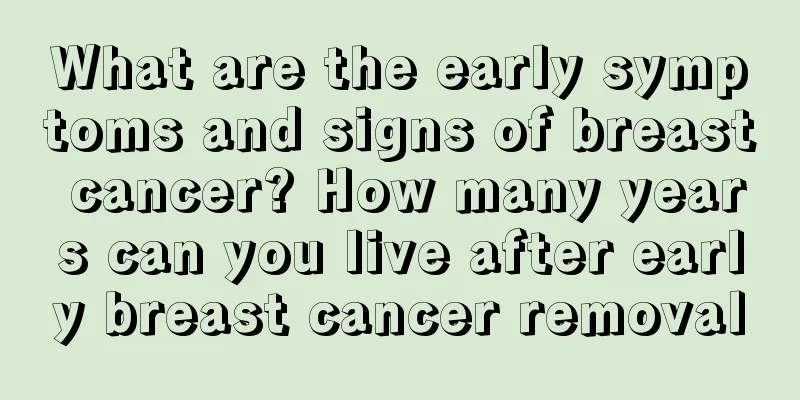What are the early symptoms and signs of breast cancer? How many years can you live after early breast cancer removal

|
Breast cancer is a malignant tumor that occurs in breast epithelial tissue. It is caused by gene mutation in breast epithelial cells under the action of multiple carcinogenic factors, resulting in uncontrolled cell proliferation. It is one of the most common malignant tumors in women. The incidence rate is higher in women between 40 and 60 years old and before and after menopause. Its onset is often related to genetics. According to statistics, more than 40,000 women die from this disease in China every year. Breast cancer has become one of the serious diseases that seriously threaten women's lives. Breast lumps In the early stage, it is a painless, solitary small lump. The lump is most commonly located in the upper outer quadrant, followed by the nipple, areola area and upper inner quadrant. There are usually no subjective symptoms. The characteristics of the lump are hard texture, rough surface, adhesion to surrounding tissues, and poor mobility. Nipple and areola abnormalities 1. Nipple changes: The nipple becomes flat, retracted, and sunken until it is completely retracted under the areola and cannot be seen. 2. Nipple itching, desquamation, erosion, ulceration, crusting, accompanied by burning pain, and nipple changes are manifestations of nipple eczematoid carcinoma (Paget's disease). 3. Nipple discharge: More than 5% of breast cancer cases are accompanied by nipple discharge, which can be milky, watery, serous, bloody, or hematopurulent. The amount can be more or less, and the intervals are also inconsistent. 4. Abnormality of areola: Inflammatory breast cancer causes inflammation of the local skin, ranging from light red to dark red. It is relatively localized at first, but soon expands to most of the breast skin, accompanied by skin edema. The skin becomes thicker, rougher, and the surface temperature rises. Breast contour and skin changes The tumor invades the Cooper ligament connecting the breast skin and the deep pectoral muscle fascia, shortening it and losing its elasticity, pulling the skin of the corresponding part, and causing the "dimple sign", that is, a small depression appears in the breast skin, like a dimple. If the cancer cells block the lymphatic vessels, "orange peel-like changes" will appear, that is, many small dot-like depressions appear in the breast skin, just like orange peel. In the late stage of breast cancer, cancer cells infiltrate into the skin along the lymphatic vessels, glandular ducts or fibrous tissue and grow, forming scattered hard nodules in the skin around the main cancer focus, the so-called "skin satellite nodules". pain About one-third of patients complain of varying degrees of dull pain, pulling pain, or tingling pain in the affected breast, which may be paroxysmal or continuous; sometimes there is pulling pain and a feeling of heaviness and discomfort in the affected upper arm and shoulder. Symptoms of distant metastasis of tumor 1. Lung metastasis invading the trachea and pleura may cause cough, chest pain, etc. Lymphangitic carcinomatosis may cause dyspnea, cough with sputum, cyanosis and chest pain, etc. 2. Pleural metastasis presents as bloody pleural effusion, with common symptoms including chest tightness, chest pain, shortness of breath and cough. 3. Bone metastases are most common in the thoracic, lumbar spine and pelvis, followed by the ribs and femurs. Patients experience persistent pain that progressively worsens. Spinal metastasis can cause paraplegia due to spinal cord compression. 4. Liver metastasis may initially cause fatigue and loss of appetite, and in the later stages, abdominal distension and pain are common. 5. Brain metastases are often multifocal, causing cerebral edema and increased intracranial pressure; symptoms include headache, vomiting, visual impairment, convulsions, and even coma. Signs of breast cancer metastasis About 1/3 of the cases have axillary lymph node metastasis. In the early stage, the ipsilateral axillary lymph nodes may be swollen, and the swollen lymph nodes are hard, scattered, and movable. As the disease progresses, the lymph nodes gradually fuse and adhere to and fix with the skin and surrounding tissues. In the late stage, the metastatic lymph nodes can be felt above the clavicle and in the opposite axilla. The cause of breast cancer has not been fully clarified. Premenopausal and postmenopausal estrogen is an obvious factor stimulating the occurrence of breast cancer. In addition, genetic factors, dietary factors, external physical and chemical factors, and certain benign breast diseases have a certain relationship with the occurrence of breast cancer. Several known risk factors for breast cancer: 1. Age: The incidence rate increases rapidly after the age of 20, is higher at 45-50 years old, continues to rise after menopause, and the mortality rate increases gradually after the age of 25. 2. If you have a family history of breast cancer, the risk is 2 to 3 times that of the normal population. 3. Other breast diseases: History of breast hyperplasia, breast fibroids, and nipple discharge. 4. Those whose menarche age is less than 13 years old. 5. Those who reach menopause age over 55 years old. 6. Those who are over 40 years old, unmarried, not pregnant, or whose first full-term child was born over 35 years old, and have never breastfed after giving birth. 7. Those who have suffered from functional uterine bleeding or uterine adenocarcinoma, or those who have used estrogen and contraceptives for a long time may increase the risk of breast cancer. 8. Food: Frequent intake of high-fat or high-animal fat, and excessive obesity. 9. Smoking and drinking. 10. Those who have a history of multiple chest X-ray or chest radiographs, or those who have received radiotherapy in the breast area, because ionizing radiation is also related to the incidence of breast cancer. 11. Mental factors: introverted personality, depressed, or experienced strong mental stimulation. 12. Metastasis to the breast from other cancers (e.g. endometrial adenocarcinoma). 1. Eat more foods rich in fiber: Obesity and weight gain may lead to breast cancer. You should eat less animal fat and more fiber-rich foods, vegetables, fruits, cereals and beans, which can reduce the estrogen in your body that may cause breast cancer and reduce the incidence of breast cancer. 2. Develop good exercise habits: Doing more exercise is not only good for your health, but also can prevent the occurrence of breast cancer. 3. Regular breast examination: ① Women aged 20-40 should do a breast self-examination within one week after their menstrual period every month; every two years, a professional physician should perform a clinical examination or mammography. ② For women between the ages of 40 and 49, in addition to regular breast self-examinations every month, it is better to have a professional breast examination once a year. ③Women over the age of 50 should perform regular breast self-examinations every month, and have a clinical breast examination and mammogram once a year. 4. Actively publicize and educate, popularize knowledge on breast cancer prevention, and promote women's self-breast examination to detect tumors early. Regular and planned screening of breast cancer-susceptible populations is the key to early detection. 5. Promote childbearing in a reasonable manner, get married at an appropriate age, and encourage breastfeeding. 6. Avoid using estrogen during menopause, control calorie intake, and reduce fat accumulation. 6. Drink less or no alcohol, eat more fresh vegetables, fruits, fungi, and legumes, and take royal jelly products in moderation. 7. Avoid unnecessary chest X-rays during adolescence. Surgery Surgery is still the main method for treating breast cancer. Commonly used surgical procedures include: radical mastectomy, modified radical mastectomy, total mastectomy, conservative surgery less than total mastectomy, and extended radical mastectomy. Radiation therapy Breast cancer is a moderately sensitive tumor to radiation, and can be used before and after surgery. Preoperatively, it kills cancer cells around the tumor and reduces the spread and recurrence after surgery, which can improve the 5-year survival rate. Generally, irradiation is performed on the supraclavicular, parasternal, and axillary areas starting 2 to 3 weeks after surgery. In addition, irradiation of bone metastasis and local recurrence can relieve symptoms. Chemotherapy Chemotherapy is a necessary systemic adjuvant therapy that can reduce the postoperative recurrence rate by 40%, requiring multiple courses of combined chemotherapy. The most commonly used chemotherapy regimen is the CMF (cyclophosphamide, methotrexate, fluorouracil) regimen. Endocrine therapy The effect of hormones is closely related to the patient's age, especially whether they are menopausal or not. Premenopausal patients are mainly treated with oophorectomy or ovarian X-ray irradiation. The use of androgens also has the same effect, especially for patients with bone metastasis. Patients with positive estrogen receptors often use anti-estrogen drugs, such as tamoxifen, which has a clear efficacy and few side effects and is usually taken for 3 to 5 years. Biological immunotherapy It is currently in the clinical trial stage and has a certain therapeutic effect, but its clinical efficacy is limited. Commonly used interferon, anti-breast cancer RNA, Baoerjia, LAK cells, interleukin-2, tumor necrosis factor, etc. Chinese medicine treatment TCM Syndrome Differentiation and Treatment 1. Liver depression and qi stagnation type Treatment method: Soothe the liver and regulate qi, resolve phlegm and disperse stagnation. Prescription: Xiaoyao powder with modifications, commonly used vinegar bupleurum, red peony root, white peony root, angelica, green peel, curcuma, scutellaria, trichosanthes, atractylodes, dandelion, selfheal, mountain aconite, orange seed, etc. 2. Spleen deficiency and phlegm-dampness type Treatment method: Strengthen the spleen and resolve phlegm, reduce swelling and disperse nodules. Prescription: Xiangsha Liujun Decoction with modifications, commonly used ingredients include costus root, amomum villosum, codonopsis pilosula, atractylodes macrocephala, poria, tangerine peel, pinellia, coix seed, elephant shell, oyster, aconite root, trichosanthes root, chicken gizzard lining, etc. 3. Chong and Ren meridians disorder type Treatment method: Harmonize Chong and Ren meridians, regulate Qi and relieve depression. Prescription: Erxian Decoction with modifications, commonly used ingredients include Curculigo, Epimedium, Bupleurum, White Peony, Fructus Aurantii Immaturus, Roasted Licorice, Ligusticum chuanxiong, Cyperus rotundus, Curcuma, Trichosanthes, Sargassum, Citrus aurantium, and Aralia dahurica. 4. Stasis and toxicity type Treatment method: Promote blood circulation and remove blood stasis, clear away heat and detoxify. Prescription: Taohong Siwu Decoction combined with Shuanghua Gancao Decoction with modifications. Commonly used ingredients include peach kernel, safflower, red peony root, angelica, honeysuckle, wild chrysanthemum, licorice, dandelion, herbaceous vine, Scutellaria barbata, Panax notoginseng powder, etc. 5. Qi and blood deficiency type Treatment method: Invigorate Qi and nourish blood, assist in anti-cancer treatment. Prescription: Bazhen Decoction with modifications, commonly used ingredients include Codonopsis pilosula, Pseudostellaria baicalensis, Atractylodes macrocephala, Poria cocos, Angelica sinensis, Astragalus membranaceus, Polygonatum sibiricum, Salvia miltiorrhiza, Paeonia lactiflora, Tangerine peel, Licorice, Cyperus rotundus, Scutellaria barbata, Taraxacum mongolic Suitable for consumption (1) It is advisable to eat more foods that have anti-breast cancer effects, such as crabs, clams, oysters, hawksbill turtle meat, kelp, asparagus, and agar-agar. (2) It is advisable to eat more foods that can enhance immunity and prevent recurrence, including mulberries, kiwi fruit, asparagus, pumpkin, coix seed, green beans, yam, mushrooms, etc. (3) For swelling, it is advisable to eat coix seed, loofah, red bean, taro, grape, lychee, water chestnut, crucian carp, mackerel, loach, etc. (4) For swelling, pain, and nipple retraction, you should eat fennel, chopped green onion, shrimp, tangerine cake, grapefruit, etc. Not suitable for consumption (1) Avoid smoking, drinking, coffee and cocoa. (2) Avoid spicy foods such as pepper, ginger, cinnamon, etc. (3) Avoid eating fatty, fried, moldy, or pickled foods. (4) Avoid eating irritating foods such as roosters. |
>>: What are the symptoms of pituitary tumors? What causes pituitary tumors?
Recommend
Four types of food that you should avoid if you have seasonal skin allergies
During the change of seasons, especially in sprin...
Can running detoxify? What is the principle?
The sweat produced by our body in daily life cont...
What does inverted eyelashes mean? Take it seriously
Eyelash inversion is a very annoying disease. In ...
Does eating apples prevent lung cancer? You should know these common sense about preventing lung cancer
Can eating apples prevent lung cancer? Many peopl...
How to wash clothes if diesel gets on them
There are still some diesel cars on the streets. ...
How to do functional exercise after breast cancer surgery
How to do functional exercise after breast cancer...
How to cool down a room quickly?
Summer is a relatively hot season, and it is easy...
How to make your baby smarter through prenatal education?
Nowadays, parents attach great importance to thei...
What to do if you get scalded by steam
Many people have experienced burns in life, eithe...
What is the cause of pulmonary effusion
Pulmonary effusion is a condition in which there ...
What happens if leukocytosis increases
White blood cells play an important role in the h...
What are the benefits of braised pork skin with green onions
I believe everyone is familiar with food such as ...
Why do people age?
Many people may not understand why we age after r...
How do dark spots on lips form
Sometimes people suddenly find black spots on the...
How to soak bird's nest with cold water
Bird's nest is a pure natural food with excel...









